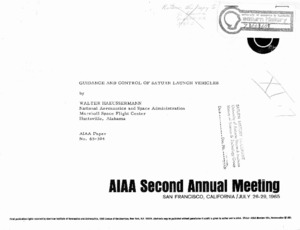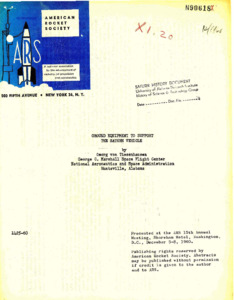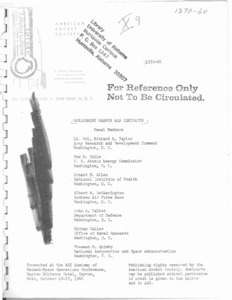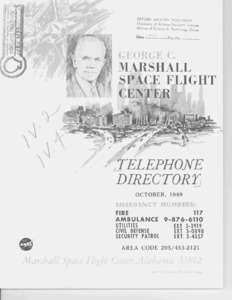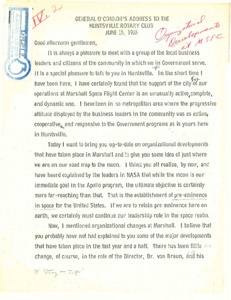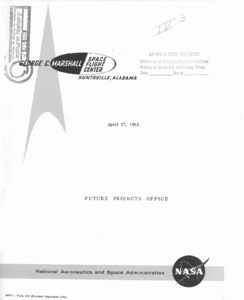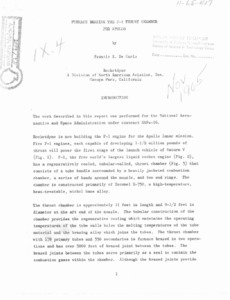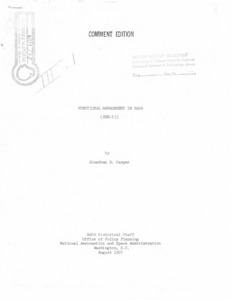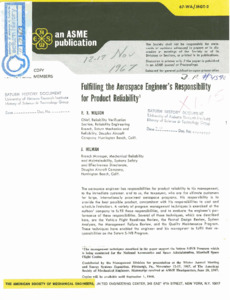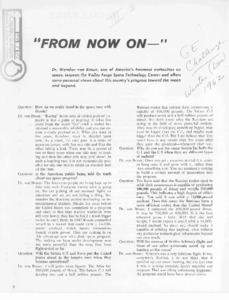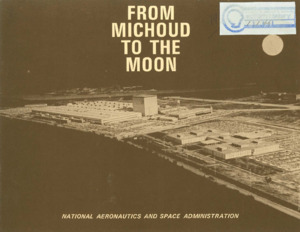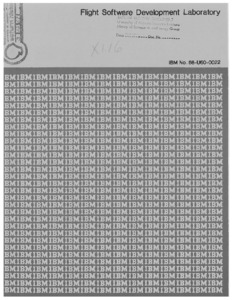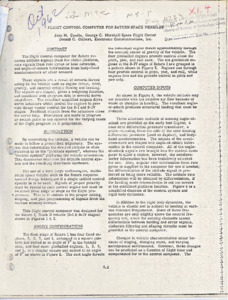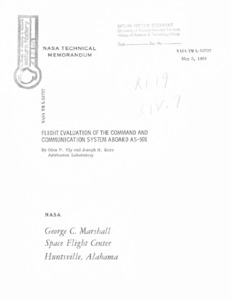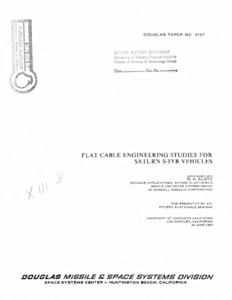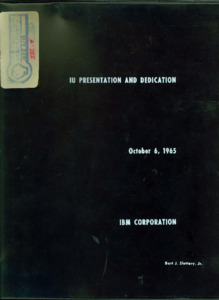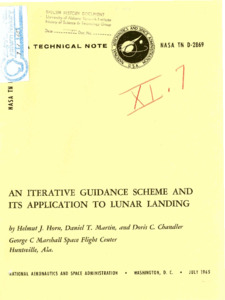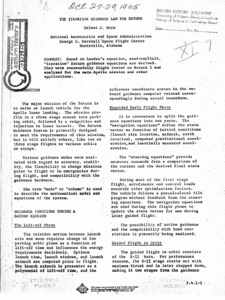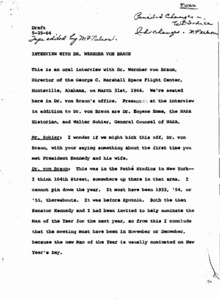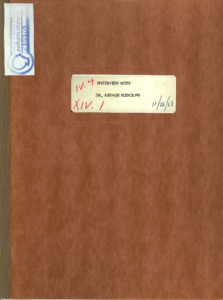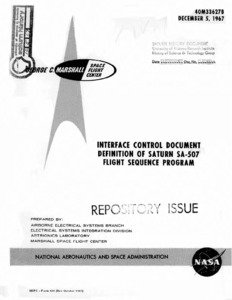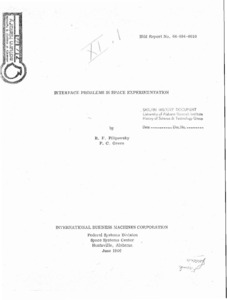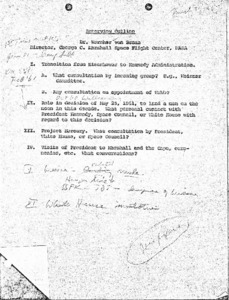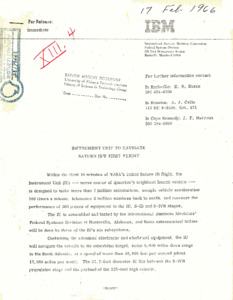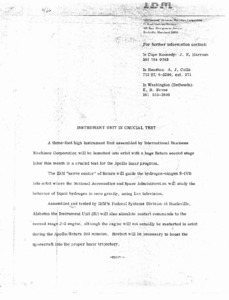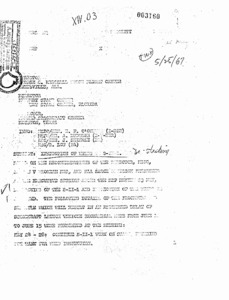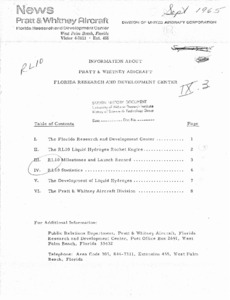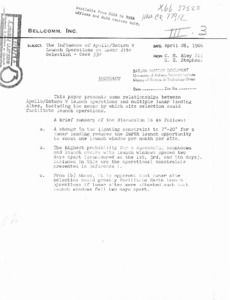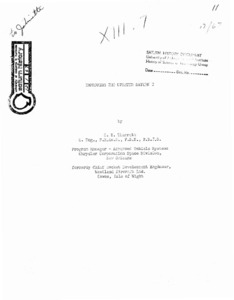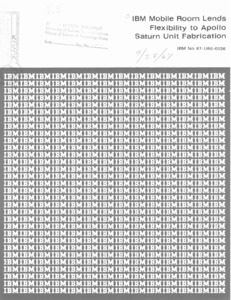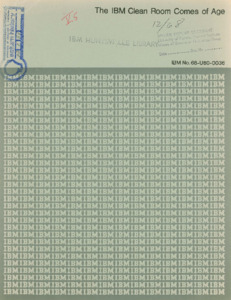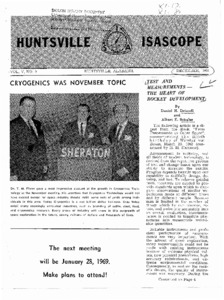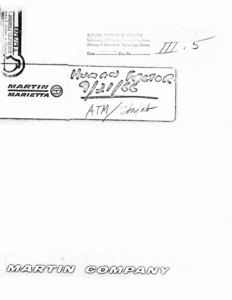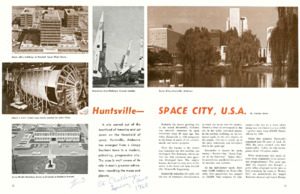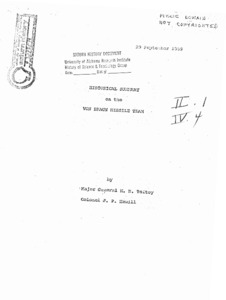
Browse Items (7888 total)
Sort by:
-
"Guidance and Control of Saturn Launch Vehicles."
The navigation, guidance, and control modes and problems of the Saturn launch vehicles are given as the requirements for the guidance and control methods. Two path adaptive guidance modes, featuring flight path optimization, in the form of a polynomial mode and an iterative mode are given in their computation form and compared with respect to mission flexibility, implementation requirements, and performance. Attitude control during the propelled flight phases requires consideration of various bending and sloshing modes; stability of the control system is obtained by phase stabilization of the low frequencies and by attenuation of the higher frequencies. Typical shaping networks and their transfer functions are given. The attitude control system during coasting periods is briefly described. The functional behavior and characteristic data of the main guidance and control hardware such as the inertial sensors, stabilized platform, digital computer, data adapter, control computer, and actuation system are described. Reliability requirements are emphasized. The principle of redundancy is extensively used to obtain highest reliability for long operating times. Data and results from recent Saturn I flights summarize the performance of the guidance schemes. -
"Ground Equipment to Support the Saturn Vehicle."
With the advent of the first large space vehicle, the SATURN, the ground support equipment and launch facility designer is faced with the necessity of conceiving and building an unprecedented launch system concurrent with the vehicle development. The paper intends to present a comprehensive picture of the problems involved and how they are solved. It follows the SATURN through the various modes of operation such as transportation over land and water, checkout, handling and erection, propellant loading, and describes the facilities at the launch site. -
"Government Grants & Contracts."
The Army medical contract, grant, and research interest in the bio-science area. -
"George C. Marshall Space Flight Center Telephone Directory October, 1969."
Information shown in the telephone directory is current as of September 12, 1969. -
General O'Connor's address to the Huntsville Rotary Club.
Address from General O'Conner to the Rotery Club bringing them up to date on organizational developments inside the George C. Marshall Center. -
"Future Projects Office."
The purpose of this brochure is to give interested readers, outside as well as within the agencies of the U.S. Government, information on the mission and activities of the Future Projects Office, George C. Marshall Space. -
"Furnace Brazing of Liquid Rocket Thrust Chambers."
Brazing as a technique for joining metal parts has been utilized for centuries. Industry, however, has only begun to use it on a wide scale in the last twenty years. The rapid growth of brazing has been a result of consumer and military demands Tor products of lighter weight, less expense, and higher performance. Today, brazing is one of the most widely used fabrication techniques in the production of liquid rockets, gas turbines, refrigerator and other types of heat exchangers, automobile parts, vacuum tubes, and many nuclear products. -
"Furnace Brazing the F-1 Thrust Chamber for Apollo."
This work described in this report was performed for the National Aeronautics and Space Administration under contract NASw-16. Rocketdyne is now building the F-1 engine for the Apollo lunar mission. Five F-1 engines, each capable of developing 1-1/2 million pounds of thrust will power the first stage of the launch vehicle of Saturn V. -
"Functional Management in NASA."
This is a Comment Edition of Historical Note No. 53 prepared by a summer employee of the NASA Historical Staff (APPH). The author has agreed to integrate comments and corrections submitted by critical readers, a normal process of validation for all historical reports and studies. -
"Fulfilling the Aerospace Engineer's Responsibility for Product Reliability."
The management techniques described in the paper support the Saturn S-IVB Program which is being conducted for the National Aeronautics and Space Administration, Marshall Space Flight Center. -
"From Now On -."
Interview with Dr. Wernher von Braun; Challenge, Winter(Dec) 1962, volume 1, number 3 -
"From Michoud to the Moon."
A history and description of the Michoud Assembly Facility in New Orleans, Louisiana. -
"Footprints on the Frontier."
An article regarding Doctor Kurt Debris, director of NASA's Kennedy Space Center. -
"Flight Software Development Laboratory."
A man-in-the-loop computer facility has been created using a digital computer, display terminal,and space vehicle flight computer to enable programmers to check out flight programs in a simulated space flight environment. The simulation requires a real time multi-programmed environment, which is supplied by a control system capable of scheduling programs on 32 levels of priority interrupt as well as answering demands for service at the display terminal. A special interface device permits visibility and control of the flight program as it executes in the flight computer. On-line inputs from the programmer at the display terminal and outputs from data collection and reduction routines to the display screen are executed in real time. The Flight Software Development Laboratory has proved to be very useful in reducing program preparation time and increasing flight program confidence. -
"Flight Control Computer for Saturn Space Vehicles."
The flight control computer for Saturn receives attitude signals from the stable platform, rate signals from rate gyros or lead networks, and angle-of-attack information from body-fixed accelerometers or other sensors. -
"Flight Evaluation of the Command and Communication System Aboard AS-501."
The first test of the command and communications system, a unified frequency S-band system, aboard AS-501 was successful. Compatibility of this system with the MSFN/USB sites was established. The onboard transponder and antenna system including antenna switching performed as predicted. The command performance was excellent with 5747 valid commands received onboard out of 5748 commands transmitted. Data reduction problems prevented a complete analysis of the tracking data. Telemetry system performance was satisfactory with a measured bit-error-rate of 4 x10-5 while over the Ascension Island station. This flight provided valuable data which can be used to define vehicle to-ground-station interfaces, to establish attitude constraints during translunar injection, and to improve operational procedures. One more test as successful as the AS-501 test would qualify the system as operational.; May 3,1968. -
"Flat Cable Engineering Studies for Saturn S-IVB Vehicles."
This paper describes the engineering approaches, investigations, results and conclusions of two National Aeronautics and Space Administration (NASA) flat-cable contracts from the George C. Marshall Space Flight Center (MSFC) to the Douglas Aircraft Company, Inc., for feasibility studies on the S-IVB stage of the Saturn Vehicle. In addition, the objectives and approaches for a third contract., "Flat-Cable Engineering Study", are discussed. A sister Douglas Paper No. 4186, to be presented by Dr. P. L. Hill, covers in detail the manufacturing aspects of the Flat-Cable Development Program.; Prepared by R.A. Klotz, Advance applications, Saturn Electronics, Missile and Space Systems Group, McDonnell Douglas Corporation for presentation at: IPC/EDN Flat-Cable Seminar, University of Southern California, Los Angeles, California, 20 June 1967. -
"IU Presentation and Dedication."
This is a note book that contains newspaper articles and photographs about the new IBM building in Huntsville, Alabama. It also has information about the Instrument Unit for the first Saturn IB flight. There is also information about the Saturn IB Instrument Unit being barged to Kennedy Space Center.; There are 2 pages that list the articles with the title, newspaper name, writer and date.; There are six color photographs that show the dedication of the IBM building and the Instrument Unit. One photograph has Dr. Wernher von Braun standing behind the ring. Two of the photographs show the Instrument Unit on a trailer being pulled by a truck.; Preferred Citation: [Identification of item] Saturn V Collection, Dept. of Archives/Special Collections, M. Louis Salmon Library, University of Alabama in Huntsville, Huntsville, AL. -
"An Iterative Guidance Scheme and Its Application to Lunar Landing."
A guidance scheme for vehicle flight from lunar orbit to a prescribed point on a spherical, non-rotating moon is presented. The equations of motion have been simplified only to perm it a closed solution for the thrust magnitude and thrust direction. The trajectory computations them selves are made under more realistic and accurate assumptions and are not included. -
"The Iterative Guidance Law for Saturn."
Summary: "Based on Lawden's equation, semi-explicit,'iterative' Saturn guidance equations are derived, many were successfully flight tested on Saturn I and analyzed for the main Apollo mission and other applications applications." -
"Interview with Dr. Wernher von Braun."
Transcription of an interview with Wernher von Braun and Mr. Sohier. -
"Interview With Dr. Arthur Rudolph."
Transcription of an interview between Davis S. Akens and Arthur Rudolph -
"Interface Control Document Definition of Saturn SA-507 Flight Sequence Program."
The purpose of this document is to define the flight sequence events, time bases, stage switch selector channel assignments, LVDA Discrete Outputs, Inputs and Interrupts for the Saturn SA-507 & Subs vehicles. Special requirements and restrictions defined in this document will be imposed on the Marshall Space Flight Center and its contractors as applicable, to insure the proper functioning of the equipment in the various stages for required vehicle timing and sequencing to occur as outlined in this Interface Control Document (ICD). -
"Interface Problems in Space Experimentation."
Space experimentation is expanding rapidly. Unmanned satellites are being equipped with precision instruments of greater power, and manned space stations accommodating large crews are in the drawing-board stage. The interface problems between these sophisticated instruments and between man, the spacecraft, and the supporting groundstations are multidimensional. This paper analyzes the scientific/technical areas of space experimentation, and continues with a review of the subsystems and support systems required to supply and operate the large variety of instruments. Areas of major integration efforts are singled out and the requirements for further developments and improvements are listed. A bibliography of 95 references is enclosed to assist in the identification of more detailed reports on all vital aspects of space experimentation.; Archive copy is a photocopy.; Supplement to IEEE Transactions on Aerospace and Electronic Systems, Vol. AES-2, No. 4, July, 1966. Pages 237 to 255. -
Von Braun, Wernher, Interview Outline.
An outline of an interview with Wernher von Braun. -
"Instrument Unit to Navigate Saturn IB's First Flight.".
Within the first 10 minutes of NASA's initial Saturn IB flight, the Instrument Unit (IU), nervecenter of America's mightiest launch vehicle, is designed to make more than 7 million calculations, sample vehicle calculations 100 times a minute, telemeter 3 million numbers back to Earth, and measure the performance of 300 pieces of equipment in the IU, S-IB, and S-IVB stages. -
"Instrument Unit in Crucial Test."
A three-foot high Instrument tional Business Machines Corporation will be launched into orbit with a huge Saturn second stage
later this month in a crucial test for the Apollo lunar program. -
"Instrumentation Programming for Computer Controlled Digital Data Processing."
A number of considerations are necessary in instrumentation programming, many of which are either not applicable or applicable to a lesser degree in other types of programming. This paper discusses these problems in general terms and illustrates how they have been dealt with specifically. The latter is done by describing the programming and operation of a data reduction system. -
"Inspection of Welds on S-II-1."
Archive copy is a poor photocopy. Cannot read. -
"Information About Pratt & Whitney Aircraft Florida Research and Development Center."
A history of Pratt and Whitney Aircraft Florida Research and Development Center. -
"The Influence of Apollo/Saturn V Launch Operations on Lunar Site Selection: Case 330."
This paper presents some relationships between Apollo/Saturn V launch operations and multiple lunar landing sites, including the means by which site selection could facilitate launch operations. -
"Improving the Uprated Saturn I."
This paper discusses five improved versions of the Uprated Saturn I that were studied by the Chrysler Corporation Space Division, supported by the Douglas Aircraft Corporation. -
"IBM Mobile Room Lends Flexibility to Apollo Saturn Unit Fabrication."
This article was published in the April 1967 issue of Contamination Control, Volume VI, Number 4. States: "The extreme sensitivity of critical parts in the Apollo /Saturn Instrument Unit (IU) has demanded unique clean room techniques by International Business Machines Corporation." -
"The IBM Clean Room Comes of Age."
A history of the IBM's Space Systems Center clean room and a description of its uses. -
IBM Apollo/Saturn Press information.
These are the facts about IBM's role as a NASA prime contractor in the Apollo/Saturn program. They are organized for quick reference. Computer terms are defined in a glossary. Glossy prints of photographs and illustrations are available from IBM information offices listed on the following page. Please order by photo number. Andrew J. Cella Manager of Information, IBM Federal Systems Division. -
Huntsville Isascope: Volume V, No. 9.
The following article is a digest from the Book, "From Peenemunde to Outer Space", commemorating the fiftieth birthday of Wernher von Braun, March 23, 1962 condensed by H. M. Hammac). -
"Human Factor: ATM /Skylab."
Statement of work: Man/Machine activities -ATM; ATM problem areas; EVA commuting problem; Other EVA considerations; Analysis of crew considerations Mission 211/212; Mission objectives Crew Considerations; Mission Fight Profile & Operations Crew Considerations; Experiment operations crew considerations; EVA equipment requirements; Crew considerations carrier recommendations; Conclusions and recommendations crew considerations; Crew operations requirements preliminary 10 August 1996; ATM stabilization and control; ATM Carrier habitability and profile; Other ATM man/machine considerations.; Original is a poor photocopy.; Document has no page numbering. -
"Huntsville: Space City, U.S.A."
An article describing Huntsville's role in various space related projects. -
"Historical Summary: S & ID Apollo Program."
Four and a half years have passed since President Kennedy and the United States Congress established a national goal of landing a man on the moon, before the end of the decade. This brief history is designed to be a working tool for use during the second half of this great adventure. It is expected that by presenting the events of the past in perspective this document will become a handy reference to accomplishments of the first half of the program. It is hoped that this volume will be of value to those directly and indirectly concerned with North American's portion of the Apollo program. This history contains a chronology of significant events, as well as material on the management of the program, a record of some of the breakthroughs in technology, a report of the hardware produced to date, and the many tests performed to man-rate the equipment.
